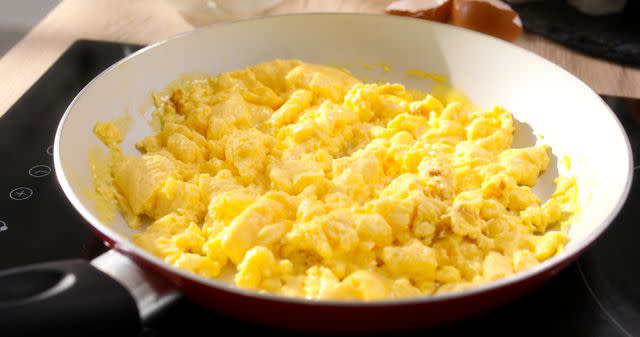How To Make the Best Scrambled Eggs, According to 10 Chefs
It’s all about the temperature at which you cook them.

Simply Recipes / Getty Images
When I don’t know what to cook, I turn to scrambled eggs. They’re obviously great for breakfast. I like them with a slice of toasted and buttered sourdough. But they also make for an easy lunch or dinner, served with a leafy, green salad dressed in a tangy vinaigrette, and maybe even a glass of light-bodied, red wine.
Needless to say, since I eat them so often, I’ve had my fair share of trial and error when it comes to scrambling eggs. I’ve picked up some methods for perfecting them over the years, but I’ve always wondered if there’s anything more that I can do to improve my scrambled egg game.
The question led me to reach out to experts for their scrambling tips. Let me tell you, their unanimous advice did not disappoint.
Read More: White Eggs vs. Brown Eggs: Farmers Explain the Difference
The 10 Chefs & Food Experts I Asked
Eric Rowse: Lead Chef-instructor of Culinary Arts at the Institute of Culinary Education’s Los Angeles campus
Ashley Lonsdale: Chef-in-Residence at ButcherBox
Nelson Serrano-Bahri: Chef and Director of Innovation at the American Egg Board.
Sally Cameron: Professional-trained chef and certified health coach at A Food Centric Life
Cynthia Christensen: Professionally-trained chef, culinary writer, and owner/recipe developer at But First We Brunch
Joanne Gallagher: Co-founder and recipe developer at Inspired Taste
Sonia Khosla: Founder and recipe developer at Love Incredible Recipes
Sarah Beth Tanner: Culinary Creative and “Eggspert” at Pete & Gerry’s
Grace Moser: Culinary writer, CEO and founder at Chasing Foxes
Yasmeen Alsawwaf: Chef and culinary writer at Yasmeen’s Kitchen Diary
The Best Way To Make Scrambled Eggs
Every single one of these chefs said the same thing: go low and slow. While scrambling some eggs in a frying pan sounds like a relatively quick process, if you’re looking for the airiest scrambled eggs, you need to take your time.
Here’s how to scramble eggs properly:
Whisk your eggs in a bowl. Then heat a non-stick skillet over low or medium-low heat. Add butter to your pan; the fat brings richness and prevents the eggs from sticking. When the butter is melted, pour the whisked eggs into your pan, and drizzle a teaspoon of water per egg.
The water will heat up and create steam, which makes the eggs fluffy. A pinch of salt at this stage also helps tenderize your eggs. Using a silicone spatula, stir the eggs continuously as they cook. The low, slow approach requires some patience, but all 10 of these experts declared the results worth the effort.

Simply Recipes / Getty Images
“High heat coagulates the proteins too quickly, making for tough, rubbery, or dry eggs. If you use lower heat and cook gently, you get creamy, moist eggsl” said Cameron, adding, “Another trick is pushing the liquidy eggs into the center of the pan with a flexible spatula as they cook.”
That’s the technique Rowse uses. “‘Proper’ scrambled eggs are constantly stirred while they cook to make the curd size smaller,” he explained. “I prefer to drag the egg to the center to let the gaps fill in with raw egg, so I get fluffy curds.”
Several of the chefs I talked to add a soft, creamy cheese toward the end of scrambling. It is key, they say, to silky eggs. Christensen dollops ricotta, mascarpone, or cream cheese into her eggs, where they result in “pockets of creaminess” and an “ultra soft” curd.
Serrano-Bahri gets a similar effect with the addition of crème fraîche, or even sour cream. Whole-milk cottage cheese offers a contrasting texture and compliments the sour cream nicely. He recommends adding a tablespoon per two eggs.
When the eggs are finished and plated, chefs suggest garnishing them with fresh herbs like chives and tarragon, a drizzle of truffle oil, or a sauce of your choice. Now that’s a proper supper!
Read the original article on Simply Recipes.


